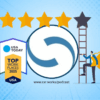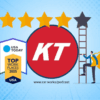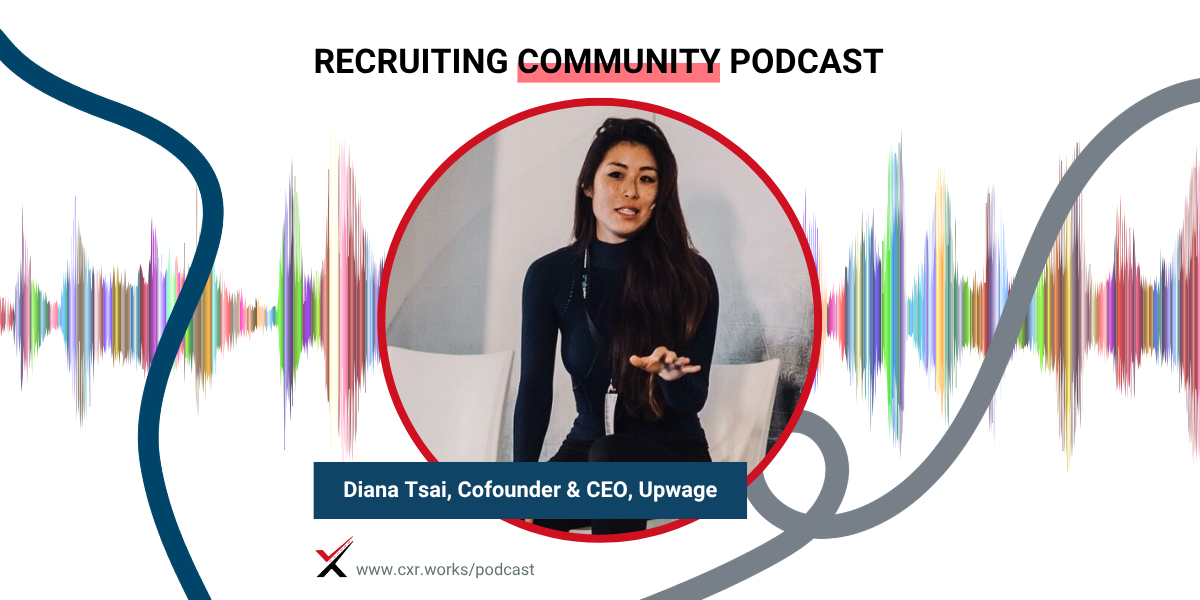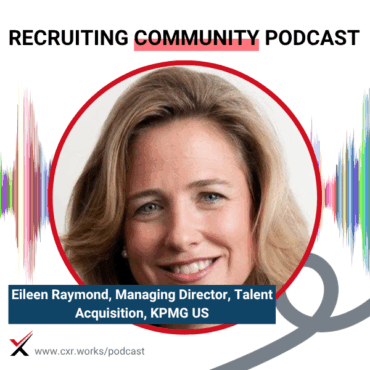Chris Hoyt: So we did a book—we did a, um—we’re live, by the way. Okay. We did a book club during the pandemic, and we would ask the members—right, we had about 6,000 members—we asked them, “What book should we be reading?” I think we actually published the leadership list of leader-chosen books.
One of the books, Diana, was The Buddha and the Badass. And the idea behind it—because I’m getting this vibe from you—is this balance of kicking ass and finding inner peace. But you said as we were coming in that you’ve got your own future book title, which I love. I’ll buy the book right now if I can do it pre-order. What are you gonna call it?
Diana Tsai: Well, this is a chapter of my life. I don’t know if there’s going to be a whole book, but The Monk and the Mermaid is a future chapter. Right now, I’m in this high-octane AI world—it’s the most intense place you can be in. That title is kind of my running centering piece.
I was telling you how my favorite books are either sports coaching books—because that’s where real leadership shows up—or soul work. Coach Wooden, Phil Jackson, Bill Walsh—those coaches wrote incredible books. Phil Jackson, in particular, to your point about The Buddha and the Badass, he brought meditation and Buddhism into his coaching practice.
Also, I’ve built GPTs—one of the first ones I built was a soul teacher GPT. It’s based on those sports coaches, with a mix of Michael Singer and other great teachers. It helps with shadow coaching—analyzing journal entries, identifying blind spots, and finding the gold in the shadow. So yeah, it’s all about finding balance.
Chris Hoyt: That’s super impressive. Do you have any Stoicism thrown in there?
Diana Tsai: I do from time to time—Marcus Aurelius, Meditations, all of that. But I lean more into Zen Buddhism, that’s really my path. But I love all practices.
Chris Hoyt: We live out in Bastrop, Texas, just outside Austin. Ryan Holiday—kind of a big name in the Stoicism world—has this bookstore on Main Street. Probably the coolest bookstore I’ve ever been in. It’s got a great selection of Buddhism, Stoicism, and a really diverse range of authors.
Diana Tsai: We could talk books all day. We don’t even need to talk about AI agents. I’ve got so many recommendations!
Chris Hoyt: I love it. And this idea of shadow coaching—that’s a whole other thing. I could talk to you all day.
Diana Tsai: Shadow coaching is particularly relevant. At conferences, folks—especially TA leaders—always ask me, “How do you use GPT?” For me, journaling is a core practice. I used to write everything down, now I talk to my GPT-based soul teacher.
I’ll say, “Here’s the situation,” and it’s trained to analyze the entry—find the blind spots, find the gold in the shadow. It also identifies shadow dynamics and Jungian archetypes in my persona. It massively accelerated my emotional resilience. Instead of needing time to reflect or see a therapist, I can recalibrate immediately. It’s like a reality check.
Chris Hoyt: It sounds like it’s not a replacement for executive coaching or mentoring—but more like a gut check. A quick reminder of your baselines—like shaking the compass.
Diana Tsai: Exactly.
Chris Hoyt: That’s a good title for a chapter: Shaking the Compass.
Diana Tsai: We’re gonna come up with a bajillion book titles today.
Chris Hoyt: I’ll argue that you are already an artist. I’ve developed this appreciation for people who are deeply passionate about their work. It’s an art to lean all the way in and try to improve an industry. I can already tell you’re doing that.
Diana Tsai: Thank you so much. That’s really kind. Especially in the venture world—when you build a company, you’re giving ten years of your life to solving a problem worth solving. So it better be something you truly care about.
Chris Hoyt: Yeah, in my fifties now—ten years is a big deal. That’s not a small investment.
Diana Tsai: It really is.
Chris Hoyt: You ready to get started? People didn’t dial in just to hear us talk about books.
Diana Tsai: Let’s go. We can go wherever you want.
Chris Hoyt: All right, here we go.
Announcer: Welcome to the Recruiting Community Podcast, the go-to channel for talent acquisition leaders and practitioners. This show is brought to you by CXR, a trusted community of thousands connecting the best minds in the industry to explore topics like attracting, engaging, and retaining top talent. Hosted by Chris Hoyt and Jerry Crispin. We are thrilled to have you join the conversation.
Chris Hoyt: I gotta say, I’m feeling the new intro. I like the new bumper.
Welcome to the Recruiting Community Podcast. We’re bringing industry insights and updates through what we think are fun conversations—all brought to you by the CXR (CareerXroads) community.
AI is revolutionizing hiring. It’s hitting talent management and the workforce in unprecedented ways—and at an outrageous pace. It’s hard to keep up. So we try to connect with folks who have their finger on the pulse. Today, we’re talking to Diana Tsai, co-founder of UPwage, about the three waves of AI transformation—how they’re reshaping recruiting, leadership, and even the job search.
The big question: is AI going to be a force for good in the future of work? Diana might surprise you.
We’re streaming on YouTube, Facebook, LinkedIn, and Twitch. You can catch past and future episodes at cxr.works/podcast. If you’re on LinkedIn and want to say hi to Diana or me—or drop a question—go ahead. Even if you watch later, we’ll get notified and try to respond.
Quick reminder—this is an ad-free labor of love. Nobody pays to be on the show. Guests are here because they’re doing cool work and we want to share it.
So let’s bring Diana back in. Diana, how are you? Welcome back.
Diana Tsai: Thank you! I’m so excited to chat with you today.
Chris Hoyt: I love it. So, I know a little bit about you—you’ve done some work with us recently—but you’re an author, serial co-founder, Georgetown grad. Give us the escalator pitch: who are you, and why should people be paying attention to you today?
Diana Tsai: I think who I am is less interesting than the problem we’re solving and what we’re building.
So here’s some context. A few years ago, my co-founder Greg was deep into his PhD research on AI and labor markets. We connected through the veteran recruiting space. I’ve always been an entrepreneur focused on tech for good.
Greg and I were obsessed with the question: what happens when AI really takes off? We knew it would create and destroy millions of jobs. So we asked ourselves, “Who’s going to safeguard workers? How do we ensure people aren’t left behind?”
Instead of resigning ourselves to a robot takeover, we asked a counterintuitive question—could we use the power of AI to combat the disruptive impact of AI itself? Could we build AI agents that reduce bias, eliminate hiring friction, and protect people from displacement?
That’s what drew us into this mission to build AI agents that reimagine how companies hire, develop, and redeploy talent. We’re partnering with companies to create an AI workforce safety net—where higher-quality talent is hired faster, and where, in the future, people can be redeployed through smart AI interviews.
Chris Hoyt: I love it. Let’s jump into the thing we teased earlier—the three waves of AI transformation. Can you break down those waves, level-set us, and tell us where most companies or TA leaders are on that curve?
Diana Tsai: Yeah. The waves of AI came out of our deployment last year—we launched 4,017 AI agents and had 1,000+ conversations with TA leaders in preparation for our book, AI for Good: How to Use AI in Hiring.
From all that, Greg and I spent time future-casting the next 10 years. We came up with three distinct waves. This is our hypothesis, and I love asking others their take on it too.
Wave One is already happening—it’s about transforming recruiting tasks. We see it playing out fully by 2026–2027, but it has a strong head start in 2025.
A few predictions: AI-driven interviews will become mainstream. There’s ROI and value in doing a pre-interview with AI before recruiters or hiring managers spend their time on calls. This helps reduce repetitive screening and bias, and frees up recruiters for more strategic conversations.
We’re seeing recruiters evolve into more of a talent advisor role. With the admin tasks off their plate, they’re focusing more on candidate relationships, employer branding, and closer partnerships with hiring managers. They’re sitting in business conversations to understand top-of-funnel needs. They’re providing white-glove service to internal candidates.
It’s actually bringing more humanness into the recruiting process.
Chris Hoyt: Um, it’s interesting—I’ll just jump in there—because the push has been, for a very long time, to transform recruiters from order takers into advisors. Like, as far back as I can remember in recruiting.
And I think we’re seeing an interesting sort of relapse, if you will, post-pandemic. A lot of leaders are coming forward and saying, “Oh my gosh, we’ve backslid into order-taking. We’ve become reactive again. We’re just waiting on the reqs. We want to be part of the conversations. We want to be part of workforce planning. We want to lean back into this.”
I love that your take is that AI helps enable this. I’m aligned with you. I agree. But I also think—and this is important—it only enables you if you’re ready for it. Just flipping the switch and turning this on doesn’t mean you’re suddenly advisors. There’s a bigger point here: the culture of the organization, the leaders, the stakeholders—they all have to be behind it.
Diana Tsai: Mm-hmm. We always think of it as product being one leg of a three-legged stool. It’s product, people, and process changes. And the people transformation is really important.
What we’ve learned from working with a bunch of recruiters—when we pair them with AI agents—is that there’s this concept of the AI-empowered recruiter. That’s the era we’re entering into. In this world, the AI-empowered recruiter is managing AI agents.
And on the other side, the AI-empowered leader is re-skilling, training, and empowering their teams to say, “Hey, let’s go hire AI agents too, to help enhance our workflow.”
Recruiters in our world are launching AI agents before clocking out so they can engage candidates they haven’t had time to reach. It frees them up for more strategic conversations within the company.
And let’s be honest: a big part of the challenge before was the lack of AI agents that were good enough to function as high-performing extensions of the recruiting team. If all you have is a basic chatbot, it’s not useful—it creates a subpar candidate experience and a watered-down recruiting process that no one wants.
Only now, in the last year or so, have we even had the technology to offer recruiters something worthy of being “hired” onto their team.
Chris Hoyt: I totally align with that, Diana. What’s interesting to me is that as the agents get better and the tech gets more sophisticated, we’re rapidly approaching a point where we can’t just think of these tools as eager interns anymore.
Right now, we tell our leaders to treat ChatGPT, Copilot, Gemini—as really eager interns. They’re going to try really hard, but you have to proof everything. You can’t just sit back and let it run. But we’re close. We’re getting super close.
Diana Tsai: We’re super close. It really runs the gamut. We’ve seen teams build agents that have decreased turnover by 48%. And we’ve seen others with glorified chatbots that don’t move the needle much, but save a little time on knockout questions.
It all comes back to the TA team. The quality of the AI agent depends on the quality of the team building and deploying it.
Chris Hoyt: I love that. So let me ask you this: how do you respond to concerns that AI is going to widen inequities in hiring rather than reduce them? I know you all have a stance on this. If I’m a TA leader and I say, “This is just going to widen the gap,” what do you say?
Diana Tsai: Great question. This comes down to two things: product design and compliance.
On the compliance side, we talk about this a lot in our AI Trust Center. Our position is—it’s not good enough to just meet the legal minimums. We’re building the technology. We know what should be regulated, so we hold ourselves to a higher standard.
Take New York’s Law 144, for example—it requires an annual third-party bias audit, which typically just covers protected classes. But what about non-protected classes? We audit for those too. We self-police. That’s how we raise the standard.
On the product side, we designed two AI agents: the AI Interviewer, which does advanced behavioral interviewing, and the AI Analyst, which acts as an invisible assessment—reviewing the transcript and identifying fit levels.
We built EEOC guardrails directly into the AI Interviewer. And before the AI Analyst ever sees a transcript, we redact all personal identifiers—no names, no demographics, no bias triggers. Just content.
Another big point: AI interviews create consistency. Many partners come to us saying, “I don’t know if my hiring managers are following interview guides.” With AI, we know the questions are being asked consistently.
And here’s the candidate experience side—about a third of candidates who do AI interviews with us do so after hours. That flexibility makes a huge difference. We recently surveyed 17,000 candidates. Our NPS score was 9.01. And the feedback?
“I was able to make dinner for my kid during the interview.”
“I did this at 3 a.m. in bed.”
It’s removing the baked-in bias of scheduling—of saying, “You only get a shot if you’re available at our convenience.”
Chris Hoyt: I remember when real data started showing up in recruiting—15, maybe 20 years ago—and it was such an “OMG” moment. When mobile hit the scene, it was like, “People are applying from their couch now!” They’re not hiding at their desk. And that’s only grown. The more consumer-first we get, the better the candidate experience becomes.
No wonder your NPS scores are high—you’re listening to the customer.
Diana Tsai: Exactly. And remember that 2011 study about judges being more lenient after lunch? Whether it’s been debunked or not, it made a great point: we’re human. When we’re tired, hungry, or stressed, our judgment is affected.
The beauty of AI is that it’s consistent. It’s always cheerful. It doesn’t get hangry.
And here’s another piece: we train our AI to use STAR interviewing and probe gently. Especially for candidates who don’t have polished resumes or strong storytelling skills, the AI can be patient and dig deeper.
Because the best hire might not be the best at interviewing. They might just need a little help bringing their story out.
Chris Hoyt: And that starts to upskill my team! If the AI is probing and following best practices that my recruiters aren’t… that’s a whole different conversation. Now we’re improving quality across the board.
Diana Tsai: We’ve seen this be especially valuable in decentralized hiring—like store managers hiring for their own locations. They’re not recruiters. They’ve never been trained to interview. They just need to fill roles.
That’s where AI interviewers shine—bringing rigor and fairness to those processes.
Chris Hoyt: Yeah—and forget the bias for a second. You just hit the nitrous button on speed and scale. That’s exponential value.
Diana Tsai: Exactly.
Chris Hoyt: And I think people miss that. But it also means the recruiter becomes an advisor. And leaders at the next level need to become conductors. Not just managers—they need to understand how to pair tools with people, how to guide, how to keep the human in human resources.
So with all that said—leadership in the age of AI is just different.
Diana Tsai: Very.
Chris Hoyt: So let me put you on the spot. What traits or practices define successful leaders today? What’s on the outs in this new AI-enabled talent era?
Diana Tsai: Ooh, great question. I’ll share what I’ve seen from the best Chief People Officers we’re working with—because we learn a lot from them.
The ones thriving in the AI age have accepted that hybrid AI-human workforces are inevitable. But there’s a choice: will AI agents be managed by the CTO and CIO, while humans are managed by the CPO? Or will the CPO own both?
That’s the emerging question.
The best leaders aren’t just rolling out AI as a tool. They’re saying: here’s the vision. Here’s how our humans and agents will work together. Here’s the structure. Here’s who we’re hiring, why we’re hiring them, and how we’ll support the team.
They treat agents like team members. They evaluate performance. They reskill and upskill their recruiters.
One CPO we worked with saw how the time savings freed up recruiters—and said, “Let’s redirect that to internal mobility. Let’s give white glove support to our internal candidates.”
That’s what this is about. This is TA becoming a revenue-driving function. That’s more interesting than time savings. That’s strategic.
And that kind of impact? You can’t get it with AI alone. It takes AI-empowered leaders and AI-empowered recruiters working in tandem.
Chris Hoyt: I love that. Absolutely love it.
Chris Hoyt: I love it. I just keep coming back to— I think it was Bill Gates who said early in this AI generation we’re in, that the company that nails the assistant—the personal assistant—is going to win the race hands down.
Diana Tsai: Yep.
Chris Hoyt: And every time I use something like OpenAI’s Operator, or code-writing tools like Claude, or even tools that summarize emails, I think about that. These tools are reaching into every level of a recruiter’s job—even up into recruiting leadership.
If you can get to a reliable agent—where each recruiter has their own “pocket me,” a shadow coach or on-demand expert—that’s incredibly powerful. The key is that it has to be reliable. You have to be able to trust it. We’re not there yet, but I think we’re getting to a point where we may not feel the need to double-check every recommendation or source that AI brings back.
Diana Tsai: Yeah. The key there is the ability to hyper-customize. We have a secret internal tool we’re releasing next month for testing—we call it the “AI Builder Agent.”
What’s really interesting about the Builder Agent is that we realized it becomes much more useful when recruiting teams can create their own AI agents. Instead of us at UPwage creating custom agents for every job like we did with the first 4,017, we give teams the power to do it themselves.
They drop in a job description, or load in their screening questions, competencies, hiring manager intake forms—whatever they want. Then we generate a fully customized AI interviewer. That’s the key: the ability to tailor it to your org, your style.
Chris Hoyt: That’s amazing. We’ve got a little secret tool too. Right now we’ve got an LLM running in our forums—its job is community engagement. When a post doesn’t get a response in two days, it starts reaching out to members who are subject matter experts, keynote speakers, etc., to ask them to weigh in or expand.
And just in the last month, we’ve beta-launched that same bot as a knowledge bot. It has five years of community data—podcasts, research, forum discussions, case studies—and it’s being tested with two groups now. They’re asking amazing questions, and the assistant is pulling up benchmarks, past convos, expert tags… and it doesn’t solve problems directly, but it’s like having an insanely smart librarian.
Diana Tsai: That’s brilliant. It’s exactly how we think of it—a knowledge layer. An intelligent assistant that curates relevant information and references the right experts. That’s the sweet spot.
And it lines up with how we think about agents in 2025. The best agents are intelligent data collectors. Then you start layering in synthesis and more complex multi-agent coordination.
Actually, you want to hear something funny? We only made it through Wave One of our “Three Waves of AI Transformation” discussion earlier!
Chris Hoyt: That’s right! We’ve got two more waves to go.
Diana Tsai: Maybe we need a whole other session for that. But let me just talk about Wave Three real quick, because it’s what I’m most obsessed with.
Chris Hoyt: Yes—100%. Tell us about Wave Three.
Diana Tsai: So Wave One was transforming recruiting tasks. Wave Three is what I gave 10 years of my life to help build. It’s what Greg and I are working toward.
Imagine a world where all the AI interviewers we’ve built, across hundreds of companies, create a network effect. That enables a multi-agent system with another layer of coordination on top. That top layer? We call it the Universal Interviewer.
This Universal Interviewer would replace traditional job applications. A job seeker would say, “Hey, I used to work in this role, I just got laid off, and here’s what I’m passionate about.” The Universal Interviewer would then identify dozens of AI agents conducting interviews across the web, and say: “Great—based on your background and goals, let’s combine these 57 job interviews into a single 45-minute AI-powered session.”
If, during that interview, the agent uncovers other roles that match—even better—it adds them on. It’s all about accelerating access to opportunity.
So when we say “layoffs shouldn’t derail careers,” that’s what we mean. This is how we build a workforce safety net for the AI era.
Chris Hoyt: That’s such a compelling vision. When you talk about “network effects,” it reminds me of atomic thresholds—like a certain number of effective agents creates self-sustaining momentum.
Diana Tsai: Yes, exactly. The next big phrase won’t be just “agentic AI”—it’ll be “networked agents” or something like that. Because when agents begin to complement each other—one doing interviews, one predicting fit, one coordinating hiring logistics—it becomes exponentially more powerful.
Chris Hoyt: Totally. And it raises big questions. Like at what point does the system know, “Hey, you already completed this skills assessment three months ago—no need to repeat, I’ll just fill in a gap”?
That’s where blockchain comes in, too—credentialing, validation, portability across systems.
Diana Tsai: Absolutely. And I don’t see this as replacing humans. I see it as empowering them. We wrote AI for Good to share that exact message: you don’t have to accept the dystopia. We’re building the future—we choose what it looks like.
Chris Hoyt: Right. And the skills will change. Not disappear—but change. The last mile will always need humans, but what they do in that mile is evolving.
Diana Tsai: Yes. Like in engineering—you used to build MVPs manually. Now AI tools get you 80% there. But finishing that last 20%? That’s where developers shine.
Same in recruiting. The real magic is in the last 20%. White-glove internal mobility. Strategic coaching. All these amazing things we never had time to do before.
Chris Hoyt: Totally agree. So with the term “agentic AI” being thrown around constantly—can you level-set? If I’m a TA leader walking a trade floor and I hear it, what should I think?
Diana Tsai: Honestly? Just ask, “What job does your AI do?” Ignore the buzzword. Think of it like hiring a person: is this an intern-level agent or an executive-level one?
Some tools do simple transcriptions. Others can predict retention or conduct behavioral interviews. Don’t get distracted by the label—focus on the actual capabilities.
Chris Hoyt: I love that. And speaking of evaluation—we recently collaborated with you on the AI RFI/RFP guidance doc. We released it under Creative Commons. You, Jerry, Alec Murphy, and others helped update it with new thinking.
Diana Tsai: Yes! We’d already built a Trust Center at UPwage, and our book AI for Good has a whole chapter on bias and future-proofing hiring. So it aligned perfectly.
I especially love the new questions around bias mitigation and second-order effects—asking vendors: “How do you handle the ethical and social implications of AI in hiring?” It’s powerful.
And we even do internal exercises where we ask GPT to imagine the dystopian outcome of our work—just to keep us grounded.
Chris Hoyt: That’s genius. Love that proactive mindset.
Okay, final question. We always ask our guests: if you were going to write a book on this subject, what would the title be?
Diana Tsai: This is a cheat—I just published that book! It’s called AI for Good: How AI Can Transform Hiring for the Better.
That’s really the mission and the movement we’re building. But if I had to explore another title? Maybe something like Using AI to Combat the Disruption of AI Itself. That could apply across industries.
Chris Hoyt: You’re one of the only people I’ve heard flip the script on AI like that. Reid Hoffman has done something similar, but you’re in rare company. You’re pushing for a future that improves humanity.
Diana Tsai: Thank you. I just believe we all have a choice. Being a bystander? That’s still a choice—and not a good one. We can’t default into a dystopia. We have to design the world we want to live in.
Chris Hoyt: Couldn’t agree more. For those listening, you can find Diana Tsai on LinkedIn. If you have trouble, just reach out—we’ll connect you. Diana, thank you so much for sharing your time, your insight, and your optimism. Can’t wait to do more together.
Diana Tsai: Thank you, Chris. So good talking to you.
Chris Hoyt: And for those who missed part of this episode or want to see what’s next, visit cxr.works/podcast. We’ll see you next time.
Announcer: Thanks for listening to the Recruiting Community Podcast, where talent acquisition leaders connect, learn, and grow together. Be sure to visit cxr.works/podcast to explore past episodes, see what’s coming up next, and find out how to join the conversation. Whether you’ve got insights to share or want to be a guest on the show, we’d love to hear from you. If you’re interested in learning more about becoming a member of the CXR community, visit us at www.cxr.works. We’ll catch you in the next episode.











